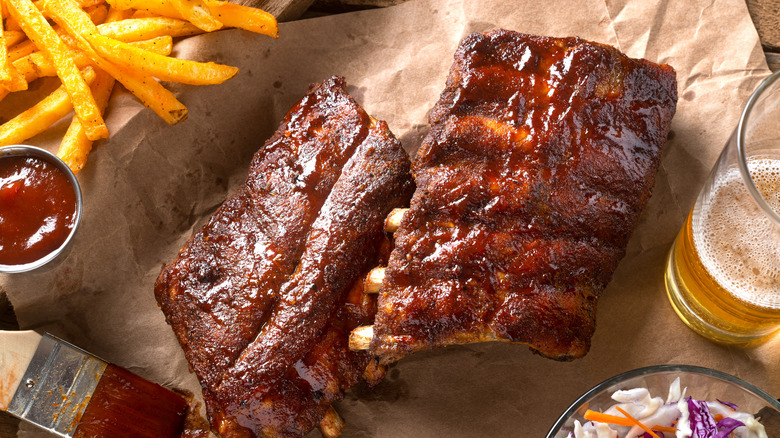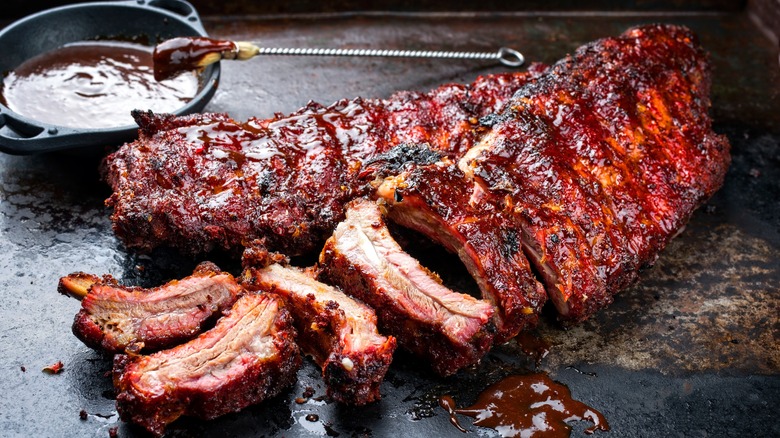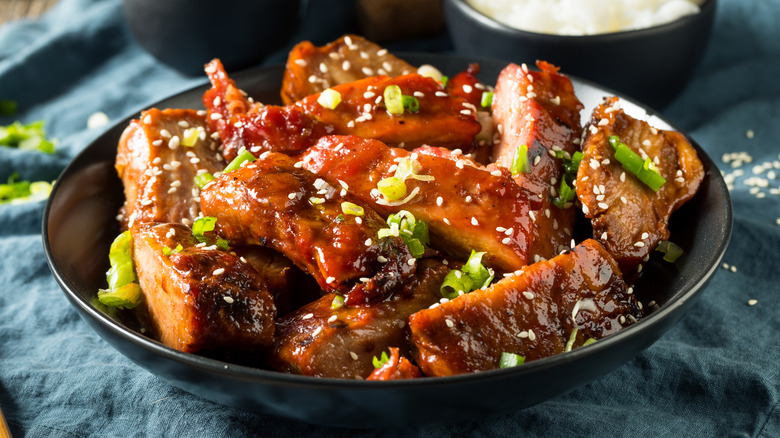What's The Difference Between Ribs And Rib Tips?
Ribs are a messy, albeit delicious food that are often associated with the southern United States, backyard barbecues, or summer grilling. As the name implies, ribs come from the rib cage of an animal, most commonly from pigs or cows, which is why we often see pork or beef ribs on a menu. It might come as a surprise, but chicken ribs are also edible (as are most parts of the animal), but these are often removed from the chicken breasts which are more valued by customers.
While ribs are indeed a more well-known cut, rib tips are also a popular commodity, which are similar, but not identical to ribs. The differences between the two come down to the specific part of the animal from which they're sourced, their texture, and their fat content — all of which impact flavor and cooking methods. Plus, rib tips are only made from pork. Knowing these differences can help you make juicy, fall-off-the-bone ribs or flavorful, crunchy rib tips.
Ribs are a tender cut while the cartilage in rib tips makes them chewy
Ribs obviously come from the rib cage of an animal and consist of long, curved bones with a generous amount of meat attached. Look at them closely and you will see that the meat is arranged in layers with the bone running through the center. Ribs are known for being a tender cut of meat with rich marbling, which is why they are often grilled, smoked, or slow-cooked. One of the best compliments you can give someone who brings over a tray of ribs is remarking on their tender, fall-off-the-bone meat.
Beef ribs generally come in one of three forms: Beef back ribs, beef chuck short ribs, and beef rib short ribs. Alternatively, pork ribs are most commonly enjoyed in one of three main cuts: Spare ribs, baby back ribs, and country-style ribs.
On the other hand, rib tips are essentially the leftover part of pork ribs. They are made from the short section that comes off of spare ribs when you — or more realistically, your butcher — trim them to make a squared cut known as the Saint Louis cut or the Kansas City rib. Rib tips have more cartilage than ribs which gives them a chewy, crunchy texture. The combination of higher fat content and cartilage means rib tips require longer cooking times to render the fat and soften the cartilage.
In theory, rib tips can be more flavorful than the meat from a rib due to their cartilage content, however, these are also often parts that are discarded because people do not like chewing through the cartilage. It's really a matter of preference.
Are they prepared differently?
In American cuisine, both ribs and rib tips are oftentimes synonymous with barbecues and grilling. So how do you decide which to make and how to prepare them?
Ribs are typically served either as a half-rack or a full rack, with the meat attached to the bone. These can be sauced, dry-rubbed, or enjoyed with various glazes or marinades. Common slatherings include Texas-style tomato-vinegar sauce, Kansas-style tomato-and-molasses sauce, Alabama white sauce, or even just your store-bought Jack Daniel's BBQ sauce.
In contrast, rib tips are served a bit differently as they are separated into smaller, bite-sized portions which make them perfect for (non-dainty) finger foods and appetizers. Generally, smoking rib tips is the way to go, however, some recipes will allow you to swap out spare ribs for rib tips. Rib tips are also a common protein option in Chinese-style bbq recipes, often accompanied by garlic, ginger, soy sauce, and five-spice powder, among other ingredients.
So whether you opt for ribs or rib tips is entirely up to you — are you hankering for tender, classic barbecue, or less common, yet flavorful pork?


